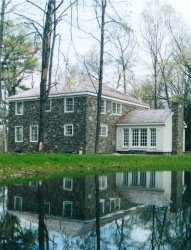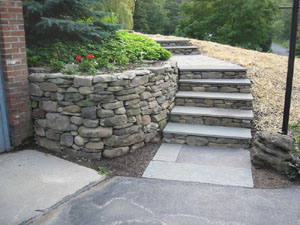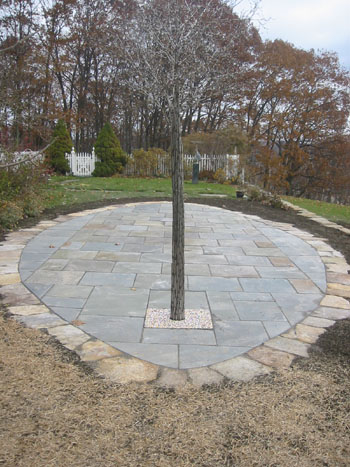|
|
|
|
Installing a Stone PatioWhen installing a flagstone or stone patio you have many options with your choice of stone to use, including broken or natural flagstone, square cut flagstone, patio pavers, brick and many more. After deciding on the stone type you will be using, mark out the area where you will be installing the flagstone patio.
After marking out the area, begin to dig down about 8 inches, going beyond your patio size by 6 inches on all sides to ensure a good base for your flagstone patio. After the dirt is removed, fill in the first 4 inches with screen fill or a similar mix of varying size from stone dust to 3/4 inch stones. After leveling off the screen fill, use a tamper to compact the base so that it will not settle over time. Depending on the size of the stone used for your patio, you should then add a layer of stone dust or sand to bring the level to within 2 inches of the final patio height you are looking for(approx. 2 inches). Then compact the stone dust or sand with a tamper. Now your base is set to lay your stone and you should setup string along the side of your patio to define the final height you want, usually pitching slightly away from a house(1/4 inch over 4 feet). The pitch helps to drain the water away from your foundation or anything else you may want to protect from water run off. Having a small pitch will also make it so you won't have puddles on your patio after a strong rain. Starting at an edge of the desired patio size, begin to lay the stone, using a dead blow hammer, level, stone hammer and string to check the stone pitch against the string you have setup. You will need to add fresh stone dust or sand under each stone to bring up to the final patio level. Once you have leveled up the stone dust or sand, place the stone and strike the stone with the dead blow hammer to ensure it is set firmly and won't settle in the future. Do not use a regular hammer to hit the stone to set it, a dead blow hammer is made to settle stones with the use of a rubber mallet head, which is half filled with sand so the force is carried down on the stone and will not rebound or break the stone. After each stone is set, check the pitch and also the level of each stone to ensure that your patio comes out level and pitched slightly if desired. Depending on the stone used, flagstone which is natural or cut is installed with a small gap(1/4 inch) between each stone. Patio pavers or brick should be installed tightly against eachother and have no gap between each brick.
Once the patio stone has been installed you should use stone dust or sand to wash into the gaps between the stones. If you used pavers or brick, use a fine sand to wash into the cracks. This will help make each stone more sturdy and less likely to rock or move in the future. Washing in is done with the use of water and a broom, going over the patio a couple times to ensure the gaps are filled correctly.
Congratulations on installing your own stone patio! If you have questions, please contact us for more information |
|
|



























